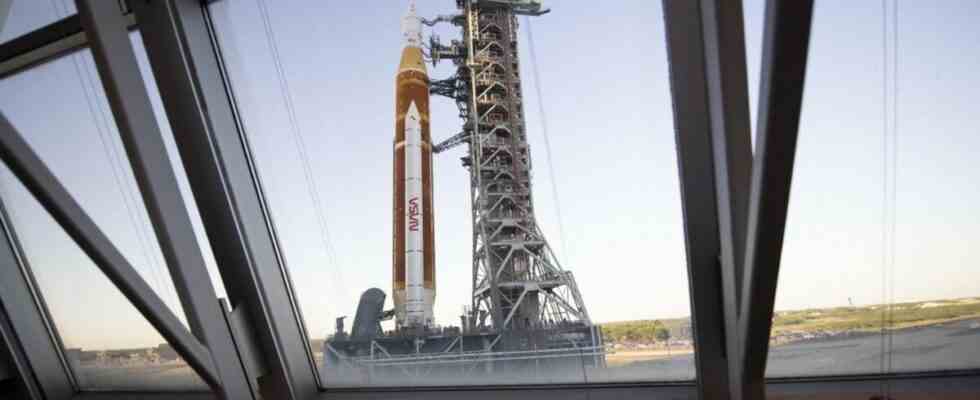“This time it’s not just about planting our flag and leaving our mark. We will establish a base for a mission to Mars. And maybe one day beyond. On December 11, 2017, Donald Trump, then President of the United States, put the Moon back at the heart of American space exploration. With this objective, given a year and a half later by the voice of its vice-president, Mike Pence, to sign the return of Man on our natural satellite from 2024.
Very optimistic. Too much, estimated on November 9 Bill Nelson, ex-astronaut and head of NASA. The Artemis program, born of this new course set by Donald Trump, has not been abandoned. It even passed an important milestone on March 18, with the arrival on its launch pad, at the Kennedy Space Center in Florida, of the rocket Space launch system (SLS). The new American heavy launcher is set to play a central role in the Artemis missions.
General rehearsal on April 3
The rocket, with on board the Orion spacecraft, still has to undergo a series of tests. On April 3, this will include loading more than 3 million liters of cryogenic fuel into it and repeating each stage of the countdown until the last 10 seconds, without triggering the engines. The rocket will then be drained of fuel to demonstrate a safe aborted launch.
If these tests are conclusive, it will then be a question of moving on to the first take-off to the Moon. This will be the Artemis I mission, the starting point of the program. “Two launch windows are advanced, between May 7 and 21 or, more likely, between June 6 and 16,” says Philippe Deloo, head of Orion’s “European service module” (ESM) program at the European Space Agency (ESA). Very soon after liftoff, the SLS will separate from its upper stage, where Orion is located, and leave the spacecraft to continue its journey to the Moon. The duration of the journey is another unknown to date. Two options are on the table depending on the launch date, says Philippe Deloo. “Orion could either make a single fraction of an orbit around the Moon before beginning a return to Earth – the mission would then last 28 days – or a full orbit plus a fraction of an orbit before, again, resuming the way to Earth – for a journey of 42 days. »
A warm-up lap before a first manned flight announced for 2024
Artemis I will be empty, without astronauts on board Orion, designed to accommodate a maximum of four. We can then see this mission as a warm-up lap. “A test of the propulsion systems and the electrical systems of the SLS and the Orion vessel”, specifies Philippe Deloo. ESA will pay particular attention to this. And for good reason, NASA is not embarking on this program alone. The European Space Agency is also involved, particularly in the design of Orion. If the capsule, where the four astronauts will take place, is entrusted to American Lockheed Martin, ESA is in charge, via its Airbus company, of the spacecraft’s service module: the ESM. A central element, since it must provide the air, water, electricity but also the thermal regulation and the propulsion necessary for the success of the Artemis missions and the survival of the astronauts.

This first mission must succeed Artemis II, scheduled for spring 2024. With astronauts on board this time, but without landing on the moon yet. The mission will consist “only” of bringing a crew of American and Canadian astronauts to lunar orbit before returning to Earth. It will therefore be necessary to wait for Artemis III to see astronauts treading the lunar ground again. A woman and a person of color, predicts NASA. The date remains unclear. At the beginning of March, Paul Martin, Inspector General of NASA, evoked 2026 at best. Either way, Artemis isn’t just aiming to tread the Moon again. The idea is also to install, in lunar orbit, the Gateway space station. It will make it possible to chain missions to the Moon and will serve as an advanced base on the road to Mars. To transport and assemble it, it will therefore be necessary to dedicate new Artemis missions.
“The only program that is not challenged by the current situation”
Enough to give long-term work to ESA. A breath of fresh air in the context of extreme tensions with Russia, which does not spare the space sector, until causing a new postponement of the European mission ExoMars2020? “Artemis is the only program that is not questioned or turned upside down,” said Didier Schmitt, coordinator of human and robotic exploration at ESA. The European agency has already been commissioned to provide six service modules for the first six missions planned. “A contract whose value is close to 2 billion euros”, specify Philippe Deloo and Didier Schmitt. And discussions are underway for the production of three more, for Artemis 6 to 9.”
Above all, the European contribution to Artemis is not limited to ESMs. ESA also provides several Gateway modules, including “I-Hab”, the main housing module of the future station. But also ” Spirit “. This second module will provide improved communications, refueling capability and even a window to observe Space *, describes the ESA. These modules are under construction by Thales Alenia Space, a joint venture between the French Thales and the Italian Leonardo. They are to be delivered in 2027, as part of Artemis IV for “I-Hab” and a year later, during Artemis V, for Esprit.
Already three tickets for Gateway for European astronauts
The icing on the cake, these American-European collaborations allow ESA to negotiate places on Artemis flights for its astronauts. She has already secured three flights aboard Gateway and does not despair of getting more, especially in exchange for additional collaborations within the framework of Artemis. Until hoping that a European one day puts a foot on the Moon? “Negotiations are underway,” said Didier Schmitt.

